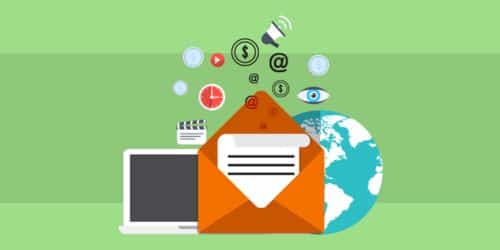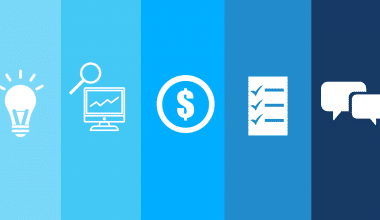Email marketing is the most successful and cost-effective direct marketing channel, with a $42 average ROI for every $1 spent. Email should be a crucial component of your digital marketing plan for this reason alone. Not using email marketing is equivalent to leaving money on the table. However, it’s very reasonable to be unsure about where to begin. Email is a broad subject. Beginners might easily become lost in a sea of tools, techniques, and terminology. Continue reading for everything you need to know about email marketing and email marketing campaigns.
What Is Email Marketing?
Email marketing is a direct marketing method via which firms may share new products, sales, and updates with their contact list. Its strong return on investment (ROI) makes it critical to the overall inbound strategy of most firms.
Modern email marketing has shifted away from mass mailings and toward consent, segmentation, and customization. This may appear to be time-consuming, but marketing automation does the majority of the heavy lifting for you. In the long run, a well-designed email marketing campaign not only increases sales, but also contributes to the development of a community around your business.
Why Is Email Marketing Important?
Email is an old technology. It was, in fact, one of the very first forms of digital communication to appear in 1971. However, even after 50 years, email marketing is more popular than ever.
You may be wondering, “Do people still use email?” Isn’t social media the place to be for marketing these days?While social media is a crucial channel in any digital marketing plan, email has various advantages.
For starters, email marketing initiatives can be more tailored than social media advertising. Following that, prices are significantly cheaper than for other channels, particularly when considering the reach and conversion rate connected with email marketing. This is one of the reasons why email marketing is perfect for small businesses.
Finally, what makes email marketing so effective and profitable is that it provides you with direct, unique access to your target audience’s inboxes.
The Advantages of Email Marketing
Emails are a crucial element of the growth and management of your business, from order confirmations to newsletters.
Email marketing can help you reach three major goals:
#1. Conversions (the sale of your goods and services)
Are you launching a discount or promotion? To increase sales, you might send an email marketing campaign to your subscribers. Additionally, use the following email marketing methods to increase conversions:
Coupons or special offers for subscribers’ birthdays/anniversaries, in welcome emails, and as a method to re-engage your audience.
When a visitor adds an item to their cart but does not check out, abandoned cart emails are sent.
#2. Brand recognition
What’s amazing about email is that it allows you to communicate with someone directly. It’s excellent one-on-one communication. And these days, people don’t just let anyone into their inbox. It’s a carefully selected environment for your favorite brands and media.
Appearing in someone’s email inbox will keep your brand fresh in the thoughts of your subscribers. A tailored marketing email has a greater impact than a social media post because you never know who saw your message.
Scalability is one of the most significant advantages of email marketing. This means that, when compared to other marketing methods, emails can be sent to a huge number of recipients while staying cost-effective.
#3. Customer devotion
Email encourages client loyalty at all stages of the buyer journey: lead nurturing, conversion, onboarding, and retention. Email marketing is also an important tool to utilize in conjunction with sales CRM systems to streamline communication.
What Is Email Marketing Campaign?
An email marketing campaign is a coordinated group of individual email messages sent over a predetermined period of time for a specific objective. Downloading a white paper, signing up for a webinar, or making a purchase are examples of specified intents or calls-to-action (CTAs).
To meet the campaign’s goal, each email must include a well-written subject line, targeted content, and a particular call to action.
A subject line, like most digital material, should strike a balance between informative and engaging, entice visitors to click without over- or under-promising what’s inside. Those who do not adequately portray what is on the inside will be evaluated accordingly.
Focused content should be relevant to both the overarching concept of your email marketing campaign and to your target audience as a whole. Marketers may choose to employ dynamic content in multiple email campaigns to appeal to different parts of their audience.
A good email marketing campaign will normally contain one main CTA with the option of a secondary CTA. Your CTA buttons should be obvious and powerful, without overpowering or detracting from the messaging.
Email campaigns are frequently sent via email service providers such as Campaign Monitor. Typically, you’ll want to segment your audience so that each section receives customized material according to their specific interests or needs.
Email marketing campaigns can be a one-time send or a series of messages delivered over a set period of time. However, while sending several messages, it’s critical to maintain consistency with your general concept, even if your CTAs alter each letter.
What Is Email Marketing Automation?
Email marketing automation is a series of emails sent after a subscriber does a certain action, such as signing up for an email list, making a purchase, or clicking a link.
Are there any drawbacks to email automation?
The only issue with email marketing automation is that it frequently necessitates some preliminary effort and planning. Planning is easier when you know what you want the end product to look like, so we’ve provided some particular examples of automated email campaigns that are perfect for beginners below to help you get started.
You’ll understand some practical and particular examples of email automation by the end of this article, and we’ll even show you a video of how to make your first automated email series in only three minutes, so keep reading!
What Is An Email Marketing Specialist?
A digital marketer that concentrates on developing email lists, generating emails, and nurturing prospects through written communications is known as an email marketing specialist.
These specialists use email automation software to send out email blasts, newsletters, and other promotional materials with the purpose of growing brand recognition and establishing a company’s position in a competitive market.
What do Email Marketing Specialists Do?
An email marketing specialist’s responsibilities vary. From using automation technologies to crafting emails and even talking one-on-one with audiences, all email marketers should expect a set of activities.
The functions and responsibilities of expert email marketing specialists are detailed below. Email marketing specialists are responsible for:
- Developing and managing a wide range of email marketing campaigns
- Ensuring that email design and layout are optimized, user and mobile-friendly
- Checking for critical messaging in and out of email templates
- Graphics requests are sent to designers.
- Creating email lists
- Email list purge
- Keeping email databases secure for future campaigns
- Responding to emails
- Making product purchases
- Making digital advertisements
- Monitoring and assessing campaign outcomes
- Contributing to further digital marketing activities.
This is only a partial list of the duties that email marketing professionals can expect to perform during their careers.
What Is The Value Of Email Marketing Specialists?
Email marketing is a marketing strategy that increases ROI. As a result, email marketing specialists are crucial since they can drive these results in the most direct way imaginable.
Email marketing experts create campaigns that drive brand efforts and increase traffic. This allows them to consolidate their position in a competitive market and ensure that their brand sees results in the short and long term.
By the end of 2019, about 250 billion emails will be sent each day.
This demonstrates the pervasiveness of email in the present era of communication. It’s a thriving industry that brands must capitalize on in order to get the leads that will propel corporate success.
These email experts foster a culture of mutual understanding and happiness. These marketers develop relationships that benefit all parties through a variety of efforts such as newsletters, lead nurturing, and more.
Companies that focus on relationship development can ensure that they retain lifelong customers with something as easy and effective as an email. An email marketing expert should be able to generate meaningful engagement at every level of the sales process, from lead generation to conversion.
Email Marketing Strategies
#1. Never, ever buy email lists.
Building an email list can take time, especially if you’re just getting started. Purchasing a list may appear to be a tempting shortcut, but trust us when we say it’s a bad idea.
Purchasing a list puts your company at risk because:
- According to GDPR and CAN-SPAM, sending unsolicited emails and storing people’s data in your CRM without their knowledge is prohibited.
- Unsolicited emails are more likely to be marked as spam, harming your email sender reputation and potentially landing you on an email blocklist.
- Because purchased lists can impair the deliverability of other users on shared IP addresses, most email marketing firms will refuse to work with you.
In a nutshell, don’t buy email lists. Build your list organically — even if it takes time — and you’ll reap the rewards in the long term.
#2. Make use of double opt-in.
The word “opt-in” relates to the signup process. For email marketing, there are two sorts of opt-ins:
When a subscriber submits the signup form, they are automatically added to the email list.
When you use double opt-in, you send a confirmation email with a link to each new subscriber. To finalize the subscription, the subscriber must click the link. They will not receive emails from you unless this verification is completed.
Yes, double opt-in adds an additional step between the potential subscriber and your list. But, far from being an impediment, this procedure is critical, particularly for email deliverability.
The use of double opt-in avoids any misspelled email addresses, which would otherwise result in a hard bounce. It also eliminates spam traps and serves as verification of subscriber consent, which is required by GDPR.
Double opt-in is the way to go for better email marketing.
#3. Divide your mailing list into segments.
As your email list grows, it is likely to include a variety of buyer profiles.
List segmentation is the process of breaking your subscriber list into smaller sub-lists with similar characteristics. The goal of this strategy is to engage subscribers with more relevant, tailored emails.
Contact lists are typically categorized by demographic information such as age and geography, as well as consumer information such as lead score and purchase history. (Having a sales CRM that integrates with your email marketing platform comes in helpful here.)
To get a good start on segmentation, ask users about their email content and frequency preferences upon signup.
#4. Personalization
People enjoy it when brands add personal touches and pay attention to the smallest of details. A little effort goes a long way in making us feel valued and understood as customers.
This is also true for email marketing.
Personalization of emails is critical for developing relationships with prospects and customers.
Here are some basic email personalization suggestions to boost your open, click-through, and conversion rates.
In the email subject line and body, use the subscribers’ first names.
When scheduling campaigns, keep time zones in mind to increase the likelihood that your email will be read. Where do the majority of your subscribers live?
Contacts should be segmented so that messaging is targeted and relevant.
Use behavior-triggered emails to communicate with clients based on how they interact with your product/service.
#5. Improve the subject line, sender name, and preview text of your email.
Subject line of an email
The email subject line is one of the most crucial aspects of your email marketing strategy.
These few words may determine whether or not your email is read. And, with so much competition in today’s inbox, they must stand out.
- In a few words, build interest or a desire to open.
- Keep the subject line to no more than 50 characters.
- Emphasize your most intriguing offer.
- Make an emotional and aspirational appeal to your readers.
Name of the sender
What is the first thing you glance at when you receive an email? That’s most likely who it’s from.
The sender’s name answers the recipient’s first subconscious question: Is this legitimate or spam?
Incorporating your brand name into the sender name is the best method to boost credibility and brand recognition. There are numerous approaches to this:
- The name of your company/brand/newsletter on its own
- A combination of your brand name and first name
- A separate sender name to distinguish different sorts of email content
- Use the same sender name and address for all campaigns to be easily identified in the inbox.
- Avoid using no-reply email addresses since they reduce trust in your brand and hinder subscribers from contacting you with questions.
Text for the preheader/preview
The email preheader (or preview text) is the text snippet that comes behind the email subject line in some email clients, notably on mobile devices.
The preheader contextualizes your subject line and can greatly increase open rates. The subject line and preheader should complement each other to begin telling the reader a tale.
Again, it should pique the reader’s interest enough to entice them to open the email and learn more.
If you don’t specify a preview text, the email client will only see the first line of text. This isn’t always an issue, but it could imply a missed opportunity to capture the attention of subscribers.
#6. A/B test the content of your email marketing campaigns.
Are you torn between two topic lines? Not sure what material will elicit the best response from your target audience? A/B testing is one method to find out — and a wonderful approach to improve the open and click-through rates of your campaigns.
Experiment with various email subject line formulas, content formats, and CTAs. Determine which ones receive the most attention and change your strategy accordingly.
#7. Improve email deliverability
More than subject lines, calls to action, and copy, email marketing effectiveness is dependent on consistent email delivery.
Email deliverability, which is critical for email marketers, refers to the ability to send an email to the inbox.
If everything goes as planned, the email will pass through the spam filters and reach its intended recipient. When deliverability is compromised, the email is routed to the spam folder or, worse, your ISP blacklists your sender’s IP address.
While technological issues frequently influence deliverability, there are numerous non-technical strategies to ensure that your email newsletters reach the mailbox.
Here are some best practices for deliverability:
- Make certain that the email subject line does not appear spammy or overly promotional. Your deliverability rate is likely to deteriorate if a contact determines your email is spam before even opening it.
- Remove unengaged contacts and inactive addresses from your subscriber database to keep it up to date.
- Send only to opt-in subscribers. Sending emails to people who have never heard of you will almost certainly result in a spam report. This will have a negative impact on your future deliverability.
- Include an unsubscribe link at all times. Individuals have the right to control how their data is used under the GDPR (Europe’s data protection regulation). Unsubscribing is entirely within those rights, so this option should always be available.
#8. Regularly purge your email list.
Maintain an up-to-date database for maximum email deliverability and higher engagement rates.
Do you have subscribers who have slipped off the radar? Send a reactivation campaign or even request a second opt-in if someone hasn’t opened your emails in at least six months. See if you can rekindle their interest.
If no one engages, remove the subscribers from your list.
While no one enjoys losing subscribers, cleansing your email list is beneficial for your deliverability in the long run.
Another critical point: Make it simple to unsubscribe by including a clearly visible unsubscribe button. People are more inclined to mark you as spam if they can’t find a way out.
A reasonable unsubscribe rate is 0.5 or less.
#9. Keep an eye on email marketing stats.
Analyzing crucial email marketing KPIs will educate you how to better your campaign strategy in the future. The majority of ESPs include an analytics dashboard that includes at least the following real-time metrics:
The ratio of the number of persons who opened your email divided by the total number of recipients is known as the open rate.
The ratio of the number of persons that clicked on a link in your email divided by the total number of recipients is known as the click-through rate.
The number of people who unsubscribed divided by the total number of receivers is known as the unsubscribe rate. If this figure is high, you should reconsider your email frequency and segmentation.
The number of emails that failed to deliver divided by the total number of emails sent is known as the bounce rate.
Soft bounces occur as a result of temporary difficulties, such as the recipient’s inbox being full.
Hard bounces, on the other hand, are caused by long-term difficulties, such as an inactive email address.
Improve your performance by properly managing your email list to increase engagement.
#10. Autoresponders and email automation can help you scale.
Once you’ve mastered the basics, automate your email marketing approach to help your company expand even quicker.
Autoresponders are the most basic type of email automation.
At various points of the buyer journey, autoresponders send an automated tailored email (or email series). You can contact subscribers without having to be physically there to send an email.
The most typical autoresponder example is the welcome email, and most email marketing providers include an autoresponder capability.
With the correct email automation software, you can go a step further and create complicated email automation sequences that include if/then/else logic. This type of email series is quite useful for lead nurturing and lead scoring.
In Conclusion,
Email marketing, being a strong, economical, and distinctive technique, should undoubtedly be part of your marketing arsenal. It has the potential to provide excellent returns with minimal work, learning, and investment.
Before sending promotional communications via email, it is critical to obtain consent. You are a visitor in your subscriber’s inbox; please be courteous and respect their decision to allow you in. Delivering what your subscribers expect is essential to great email marketing.
Every firm and/or brand’s email marketing will always be distinct. Your subscribers will stay with you as long as you remain relevant, engaging, and fresh. As your email marketing game improves, you may begin email segmentation (sending various emails to different recipients) to maximize delivery and engagement.
- HOW DOES YOUTUBE PAY: 2023 Facts and Figures
- EMAIL MARKETING SERVICES: Overview, Comparisons, Review & Top picks
- How to Build an Email Marketing List From Scratch in 10 Steps
- How to Calculate Revenue In Business Accounting (Steps and Examples)






